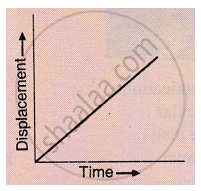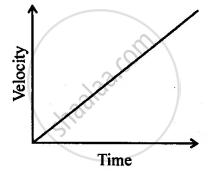Advertisements
Advertisements
Question
When a car driver travelling at a speed of 10 m/s applies brakes and brings the car to rest in 20 s, then retardation will be :
Options
+ 2 m/s2
− 2 m/s2
− 0.5 m/s2
+ 0.5 m/s2
Solution
+ 0.5 m/s2
The term “retardation” means negative acceleration.
Initial velocity = 10 m/s
Final velocity = 0 m/s
Time taken = 20 s
Acceleration = `"0-10"/20`
⇒ Acceleration = `-0.5 "m/s"^2`
⇒ Retardation = 0.5 `"m/s"^2`
APPEARS IN
RELATED QUESTIONS
A bus decreases its speed from 80 km h−1 to 60 km h−1 in 5 s. Find the acceleration of the bus.
What conclusion can you draw about the velocity of a body from the displacement-time graph shown below :

Name the quantity which is measured by the area occupied under the velocity-time graph.
A body starting from rest travels with uniform acceleration. If it travels 100 m in 5 s, what is the value of acceleration ?
A car is travelling along the road at 8 ms-1. It accelerates at 1 ms-2 for a distance of 18 m. How fast is it then travelling ?
The figure shows the displacement - time graph for four bodies A, B C and D. In each case state what information do you get about the acceleration (zero, positive or negative).

The velocity-time graph of a body in motion is a straight line inclined to the time axis. The correct statement is ___________
A body, initially at rest, starts moving with a constant acceleration 2 m s-2. Calculate: (i) the velocity acquired and (ii) the distance travelled in 5 s.
How can you find the following?
Velocity from acceleration – time graph.
Can you suggest a real-life example about the motion of a body from the following velocity – time graph?

